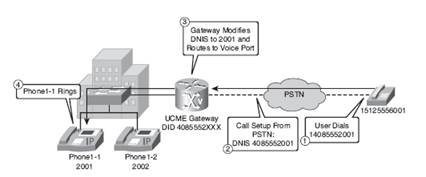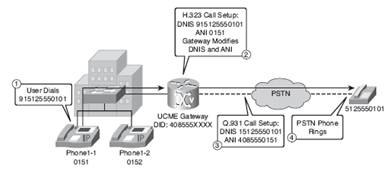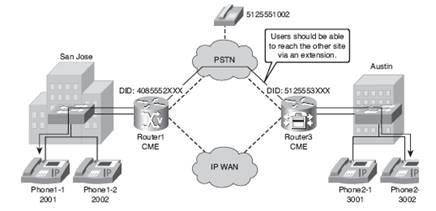Endpoint addressing – Assignment of directory numbers to all endpoints such as IP phones, faxes, and analog phones and applications such as voice mail systems, auto attendants and conferencing systems which enable users to access internal and external destinations.
Call routing and path selection – Different paths can be taken to reach the final destination, or a secondary path can be used to reach destination when the primary path is unavailable or down due to some problem such as connectivity, link issue
Digit manipulation – Sometimes digit manipulation is required to route the call such as expansion of 0 to reach the operator.
Calling privileges – different groups of users can be assigned different level of access privileges such as lobby phones or phones in public areas are only meant to reach internal numbers and executive desk phones have unrestricted PSTN access.
Call coverage – Setting up certain service as per different rules or creation of a special group of de vices to handle specific calls to ensure calls don’t get dropped and answered.
Whenever we design a large scale dial plans we need to adhere to six guiding principles:
Dial plan logic distribution – Effective distribution of dial plan logic among the various components such as call processing system, voice gateways and gatekeepers is important. As a ground rule specific tasks needs to be assigned to each device to reduce the complexity of dial plan. Such as local switch /gateway is configured to handle details pertaining to the local point of presence (POP). Higher level decisions are passed thru gatekeepers and PBXs.
Hierarchical numbering plan – Number plan must be organized hierarchically to scale the number of devices without introducing timeout or routing delays. Such design makes the plan more manageable from the perspective of addition/deletion of numbers.
Simplicity in provisioning – Dial plan need to be simple and symmetrical, consistent dial plans with set translation rules is a good design consideration as it simplifies provisioning and dial peer management
Post dial delay – While designing a large scale dial up plan we need to consider carefully about post dial delay it is the time between when the last digit is dialed and the phone rings at the other end. The more translation rules and digit manipulations exists, the longer is the post dial delay. Minimizing amount of dial peers and translations reduces the post dial delay. Also processor intensive functions such as NAT and VPNs also add to post dial delay.
Availability and fault tolerance – Fault tolerance and redundancy is important part of a VOIP network, redundant gateways need to be provided fro mission critical sites.
Conformance to public standards – Dial plans need to conform to public standards in order to have seamless integration with PSTN networks
In the subsequent sections of this CCNA voice exam lesson we will examine the requirements of a PSTN/ISDN dial plans and see how they need to be configured and used in practical / real life scenario.
PSTN Dial Plan requirements – A PSTN dial plan has three key requirements: 1) Inbound call routing – Incoming calls from PSTN need to be routed to their final destination sometimes connected directly to phones or Cisco unified communication manager. The inbound call routing also includes digit manipulation. 2) Outbound call routing – outgoing calls from PSTN need to be routed to voice interfaces of the gateway such as T1/E1 or a FXO connection. Outbound calls might require digit manipulation to modify incoming dialed number identification service or DNIS as per PSTN requirements. 3) Correct PSTN Automatic number identification service (ANIS) – This presents the calling number to end user with PSTN access code and any other identification information such as missed calls directory. Figure 1 illustrates how inbound PSTN call happens
Figure 1: Inbound PSTN Call
In the above figure example an H.323 gateway is controlled using a cisco unified communication manager. The DID range of PSTN trunk is 4085552XXX, and phone use the extension range 2XXX. The process for inbound call as follows:
- PSTN user calls 14085552001
- The call is received by gateway with DNIS of 4085552001 i.e. phone1-1
- The gateway alters the DNIS to 2001, extension of phone-1-1, and route call assigned to voice port created when IP phone registered on UCME and the phone rings
Outbound PSTN Call – Figure 2 illustrates an outbound PSTN call
Figure 2: Outbound PSTN call

The gateway sends Q.931 setup message to the PSTN with an ANI of 4085550151 and the PSTN subscriber telephone (512-555-0101) rings
ISDN dial plan requirements – ISDN trunks might have some additional configuration requirements which we will be discussing here.
Correct PSTN inbound ANI presentation depending on TON: – In some ISDN networks inbound ANI is presented as shortest dialable number combined with type of number (TON). And this may cause an issue as simply prefixing the PSTN access code will not result in creation of an ANI number which can be dialed back. This problem is addressed using digit manipulation at gateways.
Correct PSTN outbound ANI presentation depending on TON: – Some ISDN/ PBX networks expect a certain numbering plan and TON for DNIS as well as ANI. Use of wrong flags might result in incomplete calls or wrong DNIS or ANI and digit manipulation is used to address such issues.
Dial Plans configuration on a PSTN network – now we will look with the help of an example how to configure dial plan on a PSTN network. It involves the following steps:
- Configure digit manipulation for PSTN
- Configure digit manipulation for intersite calls
- Configure dial peer matching
Figure 3 illustrates a dial plan scenario.
Figure 3: Dial Plan scenario

There are two sites for which dial plans needs to be configured.
Site 1 – San Jose site
Using Cisco Unified Communication Manager Express on Router 1.
DID range 4085552XXX
DN range 2XXX
Site 2: – Austin site
Using Cisco Unified Communication Manager Express on Router 3.
DID range 5125553XXX
DN range 3XXX
For inter-site calls routing using the PSTN will need digit manipulation to change the dialed remote extension to a PSTN routable number.
Configuration of Digital Manipulation on Router 1
Router1 (config) #voice translation-rule 1
Router1 (cfg-translation-rule) #rule 1 /^4085552/ / 2/ (Voice translation rule 1 is used to change inbound called number to the actual directory number)
Router1 (config) # voice translation-profile pstn-in
Router1 (cfg-translation-profile) # translate called 1 (Voice translation profile pstn-in is used to modify the incoming called / calling number)
Router1 (config) # voice-port 0/0/0:23
Router1 (config-voiceport) # translation-profile incoming pstn-in (Voice translation profile pstn-in is bound to the voice port and used for incoming calls)
Configuration of Digital Manipulation for Outbound Calls on Router 3
Router3 (config) #voice translation-rule 2
Router3 (cfg-translation-rule) #rule 1 /^2/ /4085552/ (Voice translation rule 2 matches 2XXX four digit extension and expands to DID number 4085552XXX)
Router3 (config) # voice translation-profile pstn-out
Router3 (cfg-translation-profile) # translate calling 2 (Voice translation profile pstn-out uses to translate calling number)
Router3 (config) # voice-port 0/0/0:23
Router3 (config-voiceport) # translation-profile outgoing pstn-out (Voice translation profile pstn-in is bound to the voice port 0/0/0:23 as the outgoing voice profile)
Digit manipulation for dial peers
To allow extension short dialing to Austin on Router 1 will be configured as:
Router1 (config) # num-exp 3….915125553….
On Router3 to allow extension short dialing to San Jose configuration is as follows:
Router3 (config) # num-exp 2….914085552….
Outbound Dial Peer Matching
Both routers need to have a single dial peer to route calls to PSTN.
Router1 (config) # dial-peer voice 910 ports
Router1 (config-dial-peer) #destination-pattern 9 Router1 (config-dial-peer) #direct-inward-dial Router1 (config-dial-peer) #port 0/0/0:23 These dial peers could be used for inbound call legs also. Inbound Dial Peer Matching Dial peers need to be tuned for dial-peer matching to ensure call is accurately routed as per the requirement. On router1 dial peer 9 should be inbound dial peer for PSTN calls. Incoming call number command is used to perform dial peer matching. Inbound Dial Peer Matching on Router 1 Router1 (config)# dial-peer voice 910 ports Router1 (config-dial-peer) #destination-pattern 9[2-9]….[2-9]….. Router1 (config-dial-peer) #direct-inward-dial Router1 (config-dial-peer) #incoming called-number 2… Router1 (config-dial-peer) #port 0/0/0:23 Inbound Dial Peer Matching on Router 3 Router3 (config)# dial-peer voice 910 ports Router3 (config-dial-peer) #destination-pattern 9[2-9]….[2-9]….. Router3 (config-dial-peer) #direct-inward-dial Router3 (config-dial-peer) #incoming called-number 3… Router3 (config-dial-peer) #port 0/0/0:23 Commands to Verify PSTN Dial Plans Table 1 show commands which we can use to verify PSTN dial plans. Table 1: Commands to verify PSTN Dial plans Command Description Show dial-peer voice number To get information for a specific voice dial peer Show dial-peer voice summary To get summary of each voice dial peer Show dial plan number dial-string [carrier identifier][fax][huntstp][voice][timeout] Shows which outgoing dial peer is reached when a specific number is dialed This summarizes the lesson on dial plan functions and applications. In this lesson of CCNA voice exam we examined how dial plans are configured in a real life scenario.
